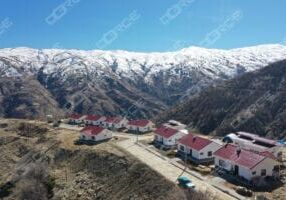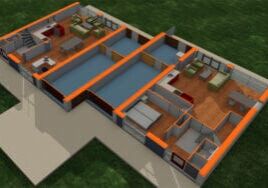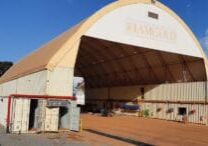The Function of HVAC Control Options
Most HVAC manufacturers provide optional protective controls for the HVAC units they produce. In the past, these controls were standard features installed on every unit, but market pressures toward cost reductions resulted in their removal as standard features/benefits in lieu of currently offering protective control as options.
The protective devices discussed in the following paragraphs are some of the usual controls available for light commercial applications.
A high pressure switch (HPS) and a low pressure switch (LPS) are protective devices for the compressor and refrigeration circuit. The high pressure switch monitors the system for an inoperative outdoor motor, and/or a dirty/restricted condenser (outdoor) coil. The low pressure switch monitors the refrigeration system for a loss of refrigerant charge, and may also be helpful in stopping the evaporator (indoor) coil from freezing up due to a dirty filter or low airflow over the coil. I say "may" because the low pressure switch cut-out setting could be set too low (15-20 lbs.) to be of any help. An evaporator coil could start to form ice at 30 lbs. low pressure charge.
If either one of these switches trip, the HVAC unit will shut down. The control needs to be reset to resume operation. Some switches are reset only from inside the HVAC unit. Others may be reset from the thermostat by turning the thermostat subbase "system" switch off, and back on again, or by doing the same to the HVAC unit's main panel circuit breaker.
A low ambient control (LAC) is useful when high internal heat loads dictate operation in the cooling mode during colder outdoor temperatures. Examples of this would be in an electrical equipment room, telecommunications building, a restaurant, or in loaded computer room applications. Extended operation of the compressor in the cooling mode when the outdoor temperature is less than 65?F can cause the indoor coil to freeze up. The low ambient control cycles the outdoor fan motor in response to refrigerant pressure and conditions. This keeps the system pressures from reaching the condition where icing would occur. Because the outdoor fan "cycles," it may appear to the end user that the condenser motor is defective. Although, this is not the case, an uninformed end user observing a low ambient control in operation could initiate a service call not covered by a first year labor warranty.
A time delay relay (TDR) protects the system against short cycling of the compressor from power interruption, and thermostat problems (due to vibrations, door slamming, or quick "putzing" adjustments by the user). The time delay relay is usually set for a 5 minute delay after the last time the compressor was energized. This device is useful in temporary mobile offices with mercury bulb thermo-stats. It protects the compressor contactor from chattering.
A dirty-filter switch is used to determine when the HVAC unit filter needs changing. It is a simple device that senses a pressure differential across the filter. From a dry set of contacts, it can turn on a light, or even cut the 24 volt power to the stat, shutting the unit off. The dirty-filter switch is manually reset from inside the HVAC unit when the filter is changed.
Start kits or start assist devices are used to help start a single phase compressor with tight bearings, or with a lower than (normal) 230 volt power supply to the compressor. A start kit includes a start capacitor and a potential relay specific to the single phase compressor in the application. A start assist device is all-in-one and is more popular with the service contractors. Some contractors feel a start assist does not provide the same boost as a start kit, but a start assist device usually gets the job done. A start kit is not meant to substitute for providing the proper voltage to the compressor.
If low main power voltage is your problem, first try to boost or improve the power supply to the building. If it can not be improved, a buck/boost transformer should be added to boost the power to the proper level required by the HVAC unit. Adding a buck/boost transformer requires monitoring of the buildings movement from one site to another. The first location may have low voltage, and the next location may not. The transformer boost of the next location may be above the operating range of the HVAC unit, and the buck/boost transformer will need to be removed from the electrical circuit.
Some units have compressor control circuit boards with a time delay relay for short cycling protection. They provide for one retry after the high or low pressure switch trips. This is to insure a condition was not a fluke before shutting the HVAC unit down. Most compressor control circuit boards can be reset inside the building by cycling either the thermostat's system switch or the HVAC unit's main panel circuit breaker to off, and then back on.
Phase monitors are used on three phase HVAC units to protect "scroll" compressors from running back-wards, and eventually seizing up. Running a scroll compressor backwards for more than an hour will pump the oil out of the bottom bearing. An hour is not a very long amount of time, especially when the set up crew does not know to turn off the HVAC unit prior to applying initial power.
Last is the brown out control. It prevents the HVAC unit from starting if the high voltage is not within the operating range of the system (usually 197-253 volts for 230 volt power supply). This control is very useful on mobile offices that continually change locations, because the available local voltage may vary from site to site. When the voltage is not within +10% of the selected voltage, the end user may only know their HVAC unit is not working, not that the voltage to the HVAC unit is too low or too high. While a brown out control would not prevent an HVAC service call, it does protect your asset from abuse. Payment for the HVAC service call then becomes the responsibility of the end user. Include such provision in your lease contracts.
Every optional control has a purpose, and therefore no one control can be recommended over the rest. From time to time, I am asked just which optional controls would be the best, and at the same time be somewhat cost effective. The "cost effective" part is fairly relative and philosophical. If a control can save the compressor from a burn out, a dirty filter from icing the coil, or a low voltage service call, how much is it worth? In other words, if a $ 50-0 control saves a $ 500-900 service call, can your company afford to put that control on every HVAC unit?
Mechanically speaking you should include all of the above items to protect the unit and yourself from problems. That wasn't the question, however. Financially, I would suggest a high and low pressure switch, a compressor control circuit board, and a two inch pleated filter. Then add the other devices as needed for the specific resolution desired. If your site continually has low voltage, add a brown out control. If your three phase HVAC units have scroll compressors, add a phase monitor. If most of your customers are telecommunication shelter users, add a low ambient control, etc.
Contact your mechanical engineer, licensed air conditioning contractor, or equipment supplier for assistance in selecting the correct optional control for your HVAC application.
More from Modular Advantage
DORÇE Navigates Mountainous Terrain, Extreme Weather to Help Rebuild Türkiye
The February 6 earthquakes in 2023 were enormous. In response, DORÇE moved quickly, obtaining a government bid to help create housing and multipurpose structures—both temporary and permanent—for earthquake victims and laborers hired for reconstruction efforts.
Modern Desert Oasis: Building Reset Hotel the Modular Way
While the off-site construction part of the Reset Hotel project has been carefully controlled and with every necessity close at hand at BECC Modular’s factory in Ontario, Canada, the remote location of the project site has created additional challenges for the on site portion of the build.
Revisiting Yellowstone Canyon Village—a Groundbreaking Modular Construction Feat—Ten Years On
With such a short building period due to impending cold, it made the most sense for park developer Xanterra to pursue modular. Yellowstone’s high visitor traffic also required some odd transportation scheduling, as traffic from the West Yellowstone entrance determined the times when trucks could unload modules. Guerdon was up to the challenge.
Built for Brutal Cold, This Modular Office Building Shines
Houlton, the county seat of Aroostook County, Maine, is a small town with a population of about 6,000 residents. Situated along the border between the U.S. and Canada, what the town is most known for is bitterly cold winters. When the U.S. Border Patrol needed new office space, a modular building approach from Modular Genius offered the perfect solution.
Panel Replacement Adds Years of Life to Navy Vessel
Panel Built, Inc., recently replaced all the wall and roof panels on a two-story US Navy barge deck house that the company had originally installed 30 years ago, giving the vessel new life. Now, the commanding officer of the unit that uses the barge said the difference between the condition and appearance from when the barge left their facility to when the project was complete was beyond his expectations of what was possible.
True Modular Building Seeks to Revolutionize Housing. It’s Next Stop: MBI’s World of Modular Europe
True Modular Building (TMB) specializes in crafting attainable, eco-friendly, and comfortable build-to-rent (BTR) housing with modern designs and customizable features, ensuring that residents feel at home both today and tomorrow.
From Toronto to Suriname: A Global Modular Building Story
When I AM Gold – a Canadian gold mining operation based in Toronto, Ontario – wanted to expand its mining operations in Suriname, it knew it would also need to expand its infrastructure. More specifically, they needed to build a mechanical services compound that would allow their local crews to maintain and equipment critical to their mining operations. They also knew that it would be a challenge.
There Were a “Sea of Challenges” for this Modular, Island Development
Question: Can modular construction be used to build a series of affordable, unique housing buildings, all styled to look like they were built in 1845, on an
island that caters to the wealthy? The answer is, of course, yes, but how the
team at Signature Building Systems and KOH Architecture got there is quite a story.
America’s Construction Economy: A Race Against Time
If the economy has been able to handle higher interest rates thus far, undoubtedly it will be able to manage the lower interest rates to come. But many economists are pointing out that the Federal Reserve may already be too late to the game. While they gradually reduce interest rates, the U.S. economy could quickly decelerate, at least based on theoretical grounds if not on the most recent data releases, culminating in that long-predicted recession. Only time will tell.
Top Five Benefits of Modular Office Space
Modular office spaces are transforming how businesses think about their work environments. These innovative structures offer a mix of flexibility, efficiency, and sustainability, making them a smart choice for companies looking to gain an advantage.










